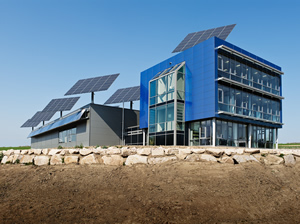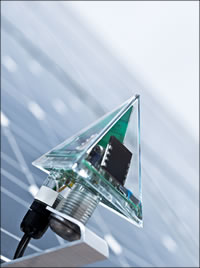Photovoltaics is without doubt the most direct way of taking advantage of solar energy. When using photovoltaics, however, the efficiency of the various systems, and the feed-in tariffs to be expected should be kept in mind. On the one hand, the capacity of the solar modules used is important - on the other hand, the way in which these modules are used has considerable influence on their cost effectiveness.
Artur Deger | DEGERenergie
Basically, there are three different technological approaches for photovoltaic systems: Rigidly installed systems, astronomical tracking systems and “intelligent“ tracking systems, which are oriented on the most energetic position in the sky or in the surroundings.
- Rigid systems originate from the beginnings of PV technology. Today, they can be found above all on the roofs of private, commercial or public buildings. In solar parks, they are being replaced by tracking systems at the same rate that word gets around among operators and investors that tracking systems work more efficiently and cost-effectively.
 Tracking systems represent a further development of fixed systems. They work according to two different principles:
Tracking systems represent a further development of fixed systems. They work according to two different principles: - astronomically-guided tracking is based on astronomical data. This means that sunrise and sunset times throughout the year are stored in the software, as well as the angle of the sun rays. The tracking systems controlled in this way align the solar modules accordingly. They do not take account of weather conditions or other parameters relevant to the energy yield, however, such as reflection effects through snow, water or light-colored rock.
- “intelligent” tracking is always oriented on actual conditions by means of light detectors. This means that the systems align the connected solar modules to the brightest, that is the most energetic, point in the sky. In this way, reflected light or diffuse light that penetrates clouds is also taken into account. DEGERenergie, world market leader in this field, has coined the term MLD (maximum light detection) for this.
Single and dual-axis tracking systems are available on the market. In single-axis systems, the solar modules are installed with a fixed angle of elevation dependent on the location – in southern European regions such as Greece this is normally around 20°. Tracking takes place only along the horizontal axis. This is why single-axis systems achieve considerably lower yields than dual-axis systems.
Cost effectiveness: Costs versus benefits
One thing is clear: If you consider the one-off investment costs alone, then rigid systems are the most favorable. Because they consist fundamentally of solar modules, support frames and inverters. Tracking systems additionally require masts, motors and the accompanying moving parts, as well as software, computer power and an IT network, depending on the technology. How much cheaper rigid systems are depends heavily on the individual system as well as the compared tracking system.
If you analyze a typical cost/benefit calculation for a solar park and include the yield of the different systems in the calculation, it becomes obvious: the bottom line is that rigid systems are some 25 percent more expensive than “intelligent“ tracking systems.
Thus, according to information provided by the Baden-Württemberg Center for Solar Energy and Hydrogen Research, Germany, dual-axis tracking systems that work on the basis of astronomical data generate some 28 percent more yield than rigidly installed solar modules. The extra yield with tracking systems that work according to the MLD principle is even higher. They extract up to 46 percent more solar energy than rigid systems, as substantiated by yield comparisons over several years.
These values apply explicitly for locations with stronger solar radiation, such as Southern Europe, as well as for locations in other regions such as Germany, for example. In Greece solar park operator KLT Energy runs two parks near Komotoni equipped with DEGERenergie´s MLD technology. Their measures show an extra yield over a twelve month period between 44 and 57 percent.
Analysis on the basis of fixed yields
In order to draw valid comparisons between the different systems, it is sensible to determine a target yield as a basis for calculation, and to compare this with the respective costs and the yields actually achieved. It shows that there is considerable potential for savings in investments simply because tracking systems require fewer solar modules and inverters, due to their additional yield, to achieve the same yield quantity as rigid systems.
In the following section, first the cost structure of a solar park with rigid systems is shown, compared with a second one that uses tracking systems“.
- Advance costs – planning (purchasing, marketing, landscape planning), site preparations, as well as freight and logistics costs. This cost item lies below 1 percent for both parks.
- Facility-related costs – installation and assembly of systems, wiring of equipment, power network connection, installation and costs for facility surveillance (fence, alarm system, video monitoring). For a park with rigid systems this accounts for some 21 percent of costs, for a park equipped with tracking systems costs lie at 18 percent. The additional costs for the park with rigid systems are down to the fact that some 30 percent more solar modules and inverters need to be used to achieve the same yield as with “intelligent” tracking systems.
- Performance-related costs – solar modules and inverters. For a park with rigid systems these account for some 70 percent of total costs, for a park equipped with tracking systems they lie at 62 percent. The reason here is also: because of the higher yields of tracking systems, fewer solar modules and inverters are required.
- Costs for substructure – supporting structures for tracking unit, elevation, foundations. These are 10 percent of total costs for rigid systems, and 19 percent of costs for tracking systems.
One issue that is continually discussed in connection with tracking systems is that of ongoing operating costs, for example from facility surveillance or repairs. In general, the operating costs of tracking systems are evaluated by insurance companies to be higher than for rigid systems installations. Thus many insurance companies make calculations with risk reductions from 0.5 to 0.8 percent of the investment volume for tracking systems.
These values are usually set too high, however. In practice, it can be seen instead that solidly built and correctly installed tracking systems do not cause significantly higher operating costs than rigid systems.
Target yield: 1 GWh per year
Below, the generation of 1 GWh of energy per year, that is, one million kilowatt hours, is taken as a guideline for a comparative calculation. Since the basic costs for astronomically guided tracking and tracking in accordance with the MLD principle are more or less identical – whereby the yield from astronomically controlled systems, as already mentioned, is considerably less – the comparison between rigid systems and dual-axis systems is based on the MLD principle.
The main factor in this calculation is the price of the solar modules used, which affects the overall investment. For this reason, the investment for the assumed yield of 1 GWh per year is calculated on the basis of a Wp price of 2 Euro, 1.50 Euro and 1 Euro.
The results:
The investment with a Wp price of 2 Euro comes to some 2.82 million Euros for dual-axis tracking systems and to around 3.56 million Euro for rigid constructions. The additional costs for rigid systems therefore lie at around 26 percent above those for MLD tracking systems.
With a Wp price of 1.50 Euro, the investment for dual-axis tracking systems comes to some 2.44 million Euros and for rigid constructions to around 3.04 million Euros. about 24 percent.
If the Wp price is 1 Euro, about 2.07 Euros must be invested for dual-axis tracking systems, and around 2.52 million Euros for rigid constructions – additional costs: about 22 percent.
According to this, the module prices have only a marginal effect on the cost/benefit analysis. In concrete terms: With a module price that is 50 percent lower (Wp price), the savings potential through dual-axis tracking is reduced by only four percentage points, from 26 to 22 percent.
It must also be taken into account in this calculation that the payback period for tracking systems is shortened accordingly, which has a favorable effect on the duration, and thus the costs, of financing.
LCOE value considerably below 20 cents
Numerous parameters must be taken into account when calculating the LCOE(Levelized Cost of Electricity) value, which is increasingly accepted as an international standard in the solar branch. These parameters not only include Total Investment Costs, but also Annual Degradation and Annual Operation as well as Maintenance Costs. Inflation as well as the Discount Rate and the service life of a system are also worth mentioning among the multitude of factors.
After aforementioned calculations, based on an irradiance of 2,200 kWh, typical of California, and using a DEGERtraker 6000NT MLD system – currently the German manufacturer’s largest system on the US market – the investor will be able to achieve an LCOE value of 14 US cents per kWh. Until now, 20 US cents were common in the solar branch.
The region of deployment plays a subordinate role in practice
For the study, the solar radiation values were used for locations in central Europe, southern Europe and the USA, along with modules of various performance classes. On the one hand, it became obvious that the region of deployment has relatively little influence on the cost/benefit analysis. However: In regions with changeable or cool but sunny weather conditions, such as in Canada, tracking systems that work with MLD technology can exploit their strengths even further. This is not least because it always aligns every single system exactly to the most energetic point in the sky. Logically – depending on weather conditions – this results in a significantly higher level of efficiency of the systems, and therefore in higher yields.
Another result: The advantage of tracking is more clearly noticeable with modules that absorb more energy. In short: With more powerful modules, tracking systems become more profitable.
Tracking systems – especially those that work according to the MLD principle – provide a considerably more balanced load profile than rigid systems, which provide high yields around midday, but comparatively low yields in the mornings and evenings. Apart from a solution to the load profile problem for public networks, this also provides a reduction in costs for inverters.
Conclusion: If you consider the investment costs alone, rigid photovoltaic systems ostensibly represent the most favorable solution. But if you compare their yield with that of tracking systems, the bottom line is that tracking is more profitable, since the additional yield is higher than the additional costs. This is especially true for dual-axis, “intelligent” tracking.
The MLD principle
The MLD, or maximum light detection, principle relies on tracking the solar module to the most energetic point in a manner that is as precise, quick and energy-saving as possible. This is owned to the control module, an acrylic pyramid (tetrahedron) with an edge length of 80 millimeters.
 The control module continually measures the intensity and angle of incoming light beams and aligns the unit with the solar modules accordingly. The module takes account not only of the radiation of the sun, but also light reflected by snow, water or light-colored rock, for example, or diffuse radiation that penetrates clouds.
The control module continually measures the intensity and angle of incoming light beams and aligns the unit with the solar modules accordingly. The module takes account not only of the radiation of the sun, but also light reflected by snow, water or light-colored rock, for example, or diffuse radiation that penetrates clouds.Two sensor cells provide reference values, which are processed and evaluated by the integrated logic chip of the control module. A differential amplifier controls the transition from the logarithmic characteristic curve during strong radiation to a linear characteristic curve during low currents, as caused by diffuse light. Because of this, the systems produce a relatively high yield, even with weak radiation. For the linear characteristic curve, the logic chip accepts a much higher value than for the logarithmic curve. This results in a significant increase in the readjustment precision with decreasing brightness. The differential voltage is additionally impinged with a load, whereby the shutdown threshold is extended up to some 30 watts per square meter, and thus into twilight conditions.
A third sensor cell on the rear of the control module ensures that the unit automatically faces the sunrise in the morning. To prevent both drives from moving at the same time in dual-axis systems, the system is designed so that the east-west drive has priority over the elevation. Each dual-axis tracking system is equipped with two control modules.
Because of the automatic tracking of each individual system – a special feature of the MLD principle compared with astronomically guided tracking – a central control system, as well as wiring up the park with data cables, are not necessary. This has considerable effects on the cost effectiveness of solar parks: With varying and quickly changing cloud conditions, for example, MLD control modules always independently move each system in the entire park to the optimum position. This means that each unit achieves the highest possible energy yield in each case.
 Artur Deger is the founder and managing director of DEGERenergie. He developed the MLD technology (maximum light detection), with which DEGERenergie progressed to become the world market leader in the field of tracking systems for solar installations.
Artur Deger is the founder and managing director of DEGERenergie. He developed the MLD technology (maximum light detection), with which DEGERenergie progressed to become the world market leader in the field of tracking systems for solar installations. About DEGERenergie (www.DEGERenergie.com):
Headquartered in Horb am Neckar, Germany, DEGERenergie is a global producer of leading-edge products. Founded by Artur Deger in 1999, the company is now the global market leader for solar tracking systems, with more than 30,000 systems installed in 38 countries. The company currently has a staff of 40, with DEGERenergie suppliers employing an estimated further 340 employees.
As a company, the focus of DEGERenergie's philosophy and activities is the design, development and manufacture of tracking systems to control photovoltaic modules in solar technology systems. Operators who deploy these tracking systems will see significantly better utilization of solar energy than with static systems, since installations working with DEGERenergie systems can achieve improvements in energy yield of up to 45 percent. In 2001, the German state of Baden-Württemberg presented its Inventor Award to the patented control module DEGERconecter: today, more than 57,000 units have been deployed worldwide.
The content & opinions in this article are the author’s and do not necessarily represent the views of AltEnergyMag
Comments (0)
This post does not have any comments. Be the first to leave a comment below.
Featured Product

MORNINGSTAR - GenStar MPPT
GenStar MPPT is the industry's first fully integrated solar DC charging system, an all-new design with "lithium DNA" from the leader in charge controllers. Out of the box, GenStar is an overachiever-delivering legendary Morningstar quality, efficiency, power and reliability along with the latest in advanced communications and control technologies. All the most installer-requested features are on-board; additional features can be easily added via Morningstar's ReadyBlock expansion technology, with snap-in blocks that provide battery metering and monitoring, signaling and load control, and lithium battery communications/control

